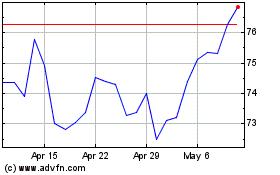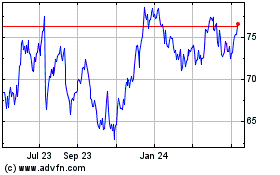The largest U.S. financial companies have made progress in
overhauling their pay practices to limit incentives for risky
behavior, but need to do more to comply with new guidelines set by
bank regulators last year, a Federal Reserve report says.
After the financial crisis of three years ago, U.S. lawmakers
and regulators began scrutinizing executive and employee
compensation at financial firms to try to stamp out any pay
practices that could lead toward dangerous behavior, such as bets
on complex financial products that threatened the financial system
in 2008.
Federal regulators adopted guidance on incentive compensation in
June 2010 and have been requiring large companies to develop plans
to revamp their compensation practices. While pay practices have
improved, the report said, "most firms still have significant work
to do" to comply with the new guidelines.
The report examined 25 firms but didn't provide any breakdown of
pay practices at each company. The Fed said such an analysis "could
be misleading" because of changing pay practices.
The Fed report on risk-taking incentives for financial
executives and rank-and-file workers alike, released Wednesday,
comes as pay practices on Wall Street have continued to be a
contentious public issue. Anti-Wall Street protests in New York and
other U.S. cities have put a spotlight on pay and bonuses for
financial executives, while the nation struggles with a weak
economy and the threat of a return to recession.
Before the financial meltdown, regulators allowed firms to
determine pay themselves. But pay is now seen as a factor that
could make a firm and the broader financial system vulnerable to
collapse.
"The financial-services industry has adjusted the compensation
practices to align the long-term interests of executives with
customers and shareholders," said Scott Talbott, senior vice
president for government affairs at the Financial Services
Roundtable, which represents the largest 100 U.S. financial firms.
"The adjustments have eliminated those pay practices that
encouraged excessive risk taking."
Timothy Ryan, chief executive of the Securities Industry and
Financial Markets Association, said many of the changes were
already being put in place by corporate boards' executive
compensation committees.
"The shareholders want compensation to be linked to
performance," while limiting risks, Ryan said. "It's about making
money in a reasonable fashion, without excessive risk."
The firms "now recognize the importance of establishing sound
incentive compensation programs that do not encourage imprudent
risk taking for those employees who can individually affect the
risk profile of the firm," the report said.
Common changes include adjusting incentive compensation for the
risk an employee's activities could pose, deferring payouts to take
into account whether the employee's activities wind up producing
profits or loses.
For example, senior executives, on average, now have deferred
more than 60% of their incentive compensation, higher than an
international guideline. More senior executives, the report said,
have more than 80% deferred, the report said.
Since the financial crisis, the U.S. and other governments also
have imposed "clawback" requirements to recoup pay if a firm
collapses or experiences big losses. For example, the Dodd-Frank
financial overhaul law gives bank regulators the power to recover
two years worth of pay made to senior executives and directors
deemed responsible for a firm's failure.
Before the financial crisis, the report noted, most firms didn't
pay much attention to risk-taking incentives, or only examined pay
for the most-senior employees. But now the firms are "attentive to
risk-taking incentives for large numbers of employees below the
executive level," the report said.
The report, however, said there is still work to be done. "Some
firms are still working to identify a complete set of mid- and
lower-level employees, and others are working to ensure their
process is sufficiently robust," the report said.
The report examined pay practices at Ally Financial Inc.,
American Express Co. (AXP), Bank of America Corp. (BAC), Bank of
New York Mellon Corp. (BNY), Capital One Financial Corp. (COF),
Citigroup Inc. (C), Discover Financial Services (DS), Goldman Sachs
Group Inc. (GS), J.P. Morgan Chase & Co. (JPM), Morgan Stanley
(MS), Northern Trust Corp. (NTRS), PNC Financial Services Group
Inc. (PNC), State Street Corp. (STT), SunTrust Banks Inc. (STI),
U.S. Bancorp (USB) and Wells Fargo & Co. (WFC).
It also examined the U.S. operations of Barclays PLC (BARC.LN,
BCS), BNP Paribas SA (BNP.FR, BNPQY), Credit Suisse Group AG
(CSGN.VX, CS), Deutsche Bank AG (DBK.XE, DB), HSBC Holdings PLC
(HSBA.LN, 0005.HK, HBC) Royal Bank of Canada (RY.T, RY), The Royal
Bank of Scotland Group PLC (RBS.LN, RBS), Societe Generale SA
(GLE.FR, SCGLY), and UBS AG (UBSN.VX, UBS).
-By Alan Zibel, Dow Jones Newswires; 202-862-9263;
alan.zibel@dowjones.com
State Street (NYSE:STT)
Historical Stock Chart
From Jun 2024 to Jul 2024

State Street (NYSE:STT)
Historical Stock Chart
From Jul 2023 to Jul 2024
